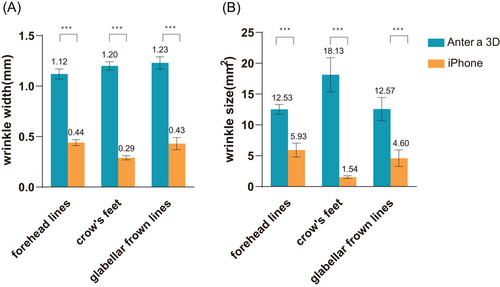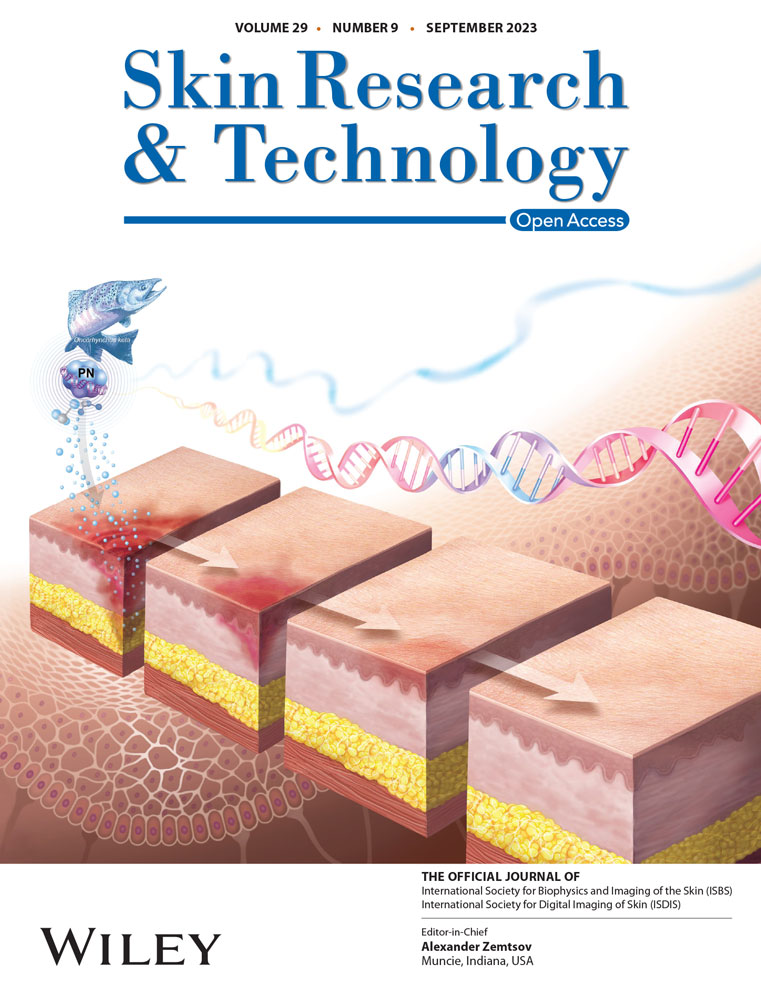iPhone 13 Pro Max photography for quantitative evaluation of fine facial wrinkles: Is it feasible?
Dear Editor,
Wrinkles are a highly representative skin aging feature, especially on facial skin, and the appearance of fine lines and wrinkles has become a major concern of people seeking rejuvenation.1 Increasing researches on wrinkle prevention or treatment highlight the need for an effective evaluation. In addition, wrinkle detection has some research applications in age estimation, age simulation, and aging recognition.2 In recent years, many skin testing instruments have been continuously developed and applied.3-7 There are differences in imaging principles between different devices, and different algorithms are used in the analysis system, so it is challenging to develop a unified quantitative wrinkle evaluation system. Moreover, dedicated devices are expensive and subject to site limitations, hindering their application to outpatients with high mobility. The smartphone revolution has made gadgets more accessible and inexpensive, resulting in widespread use.8 Smartphone use has evolved beyond standard applications, including high-quality on-the-go clinical imaging.9 As one of the necessities of most contemporary people, smartphones are relatively low-cost, portable, and network friendly for resource sharing, which is vital for developing telemedicine for doctor-patient communication or learning exchange.10
Smartphone photography has been preliminarily applied to clinical studies in ophthalmology, dermatology, otorhinolaryngology, and dentistry.11-14 However, there have been no quantitative studies on detecting fine facial wrinkles. Our current study investigated the feasibility of applying iPhone cameras to quantitatively evaluate fine facial lines in a realistic clinical setting and then explored the prospect of promoting telemedicine application. Images of volunteers' facial wrinkles were captured with digital imaging devices and smartphone cameras, respectively, and single wrinkles were measured and analyzed.
A total of 148 facial wrinkles collected from 12 healthy volunteers (mean age 48.9 years old) included forehead lines (n = 49), crow's feet (n = 70), and glabellar frown lines (n = 29). Each wrinkle identified by the naked eye of the volunteer and the researcher was measured quantitatively. The measurements were performed by Antera 3D (Miravex Limited, Dublin, Ireland) and iPhone 13 Pro Max (Apple Inc, CA, USA) in a controlled environment (22-24°C, 30%−40% relative humidity). After Antera 3D camera acquired the images, the target wrinkles were selected, and the system automatically calculated the average width and size of the wrinkles (Figure 1A). The smartphone photographs were performed perpendicular to the skin surface, and the images were imported into the ImageJ software 1.53q (National Institutes of Health, USA). First, a scale calibration was performed, and the width and size of the wrinkles were measured within the interested wrinkles by the straight-line tool and polygon tool. Five sites were randomly selected, the wrinkle width was measured at each of those sites (connecting the edges perpendicular to the axis of the wrinkle at that point), and the average of the five sites was taken as the wrinkle width measurement (Figure 1B). Outline along the wrinkle edge and click “Measure” to obtain the wrinkle size (Figure 1C).

We obtained clear, clinical-satisfied photos by iPhone photography and combined the widely used open-source software ImageJ. We easily collected quantitative measurements of fine lines. In all measured regions, the wrinkle widths from smartphone photographic images were significantly smaller than the values analyzed by Antera 3D (forehead lines: t = 62.53, p < 0.001; crow's feet: t = 33.67, p < 0.001; glabellar frown lines: t = 22.99, p < 0.001); similarly, the wrinkle sizes of iPhone photographs were also significantly smaller than the values measured by Antera 3D (forehead lines t = 11.52, p < 0.001; crow's feet: t = 6.241, p < 0.001; glabellar frown lines: t = 9.07, p < 0.001) (Figure 2). The high correlation of the data compared with widespread instruments initially verified the feasibility of its clinical application (Table 1). The correlations were relatively weak in the measurements of the crow's feet. This may be because the periorbital skin structure and morphology are relatively complex, and the Antera camera is more disturbed in its judgment of wrinkles and skin folds. We believe that the artificially identified wrinkles in smartphone camera photos are more consistent with the results observed by the naked eye in life. The difference between the illumination system and algorithm system of the Antera 3D and the naked eye observation may also contribute to the significant differences in absolute values between the two devices.

| a | b | r | p-Value | |
|---|---|---|---|---|
| Forehead lines | ||||
| Wrinkle width | 0.915 | −0.581 | 0.972 | 0.001 |
| Wrinkle size | 1.258 | −9.832 | 0.881 | 0.020 |
| Crow's feet | ||||
| Wrinkle width | 0.424 | −0.214 | 0.899 | <0.001 |
| Wrinkle size | 0.043 | 0.754 | 0.544 | 0.044 |
| Glabellar frown lines | ||||
| Wrinkle width | 0.738 | −0.478 | 0.842 | 0.035 |
| Wrinkle size | 0.647 | −3.524 | 0.903 | 0.014 |
- Note: The linear regression equation is y^ = b+ax. The measurements from Antera 3D are the independent variables x, and the measurements from iPhone are the dependent variables y^. a represents the regression coefficient, b represents the intercept, and r is the correlation coefficient. p < 0.05 is of statistical significance.
The smartphone cost is relatively low and does not require the assembly of a specific analysis system. The universal model and commercialized IOS operating system not only reduce the bias caused by the inconsistency of devices but also is favorable to apply in resource-deficient settings and generate a unified quantitative evaluation system for wrinkles. Problems with the equipment used in the previous studies (e.g., unclear magnification, unstable imaging, inability to quick focus) 15-17 have been improved in iPhone 13 Pro without additional adapters.
The key advantage of this technology is direct video documentation, instant digital storage, and easy image sharing. These documented findings aid in various ways, including comparative evaluation during follow-ups, as a teaching tool for trainees, and for gaining expert opinion via online sources. If widely employed, smartphone photography-based remote evaluations utilizing store-and-forward and real-time telemedicine interactions can also analyze a broader subset of the community's population, giving plastic practices a method to maintain care delivery throughout this pandemic.18, 19
It is noted that smartphone photography still has shortcomings, one of which is lacking depth information. However, the accurate determination of wrinkle depth is still a general pending technological breakthrough for currently used instruments. This study mainly acts as a proof of concept pilot study for more extensive deployment of the innovative measuring. Further research could include large sample sizes and multiple skin types for analysis. Moreover, artificial intelligence combined with smartphone photography might significantly reduce the workload of clinicians by automatically recognizing the edges of the targeted fine wrinkles.
Our study is the first to apply iPhone photography to measure fine facial lines quantitatively in a clinical setting. Single fine lines could be accurately identified by the naked eye in the photographs obtained, and the measurements of their width and size showed significant strong correlations with the readings of the digital skin test device, suggesting the feasibility of this technique for the quantitative evaluation of fine lines. We hope the application of smartphone photography will facilitate a universal quantitative wrinkle evaluation system and the substantial progress of telemedicine.
ACKNOWLEDGMENTS
This work was supported by Clinical Research Plan of SHDC (grant number: SHDC2020CR3070B), Shanghai Jiao Tong University School of Medicine Two-hundred Talent (grant number: 20161420), Clinical Research Plan of Shanghai 9th People's Hospital affiliated to Shanghai Jiao Tong university School of Medicine (grant number: JYLJ202108), Shanghai Jiao Tong University Interdisciplinary Plan (grant number: YG2022QN048), and Science and Technology Commission of Shanghai Municipality (grant number: 22MC1940300).
CONFLICT OF INTEREST STATEMENT
The authors declare that there is no conflict of interest that could be perceived as prejudicing the impartiality of the research reported.
FUNDING INFORMATION
Clinical Research Plan of SHDC, Grant Number: SHDC2020CR3070B; Shanghai Jiao Tong University School of Medicine Two-hundred Talent, Grant Number: 20161420; Clinical Research Plan of Shanghai 9th People's Hospital affiliated to Shanghai Jiao Tong university School of Medicine, Grant Number: JYLJ202108; Shanghai Jiao Tong University Interdisciplinary Plan, Grant Number: YG2022QN048; Science and Technology Commission of Shanghai Municipality, Grant Number: 22MC1940300
ETHICS STATEMENT
This study was approved by the institutional ethical committee, and all the volunteers were fully informed consent. Written consent from volunteers for the images was obtained.
Open Research
DATA AVAILABILITY STATEMENT
The data that support the findings of this study are available from the corresponding author upon request.




